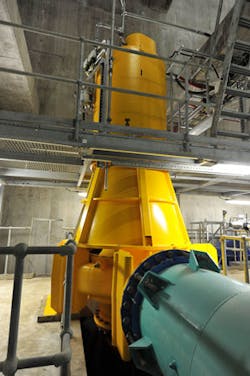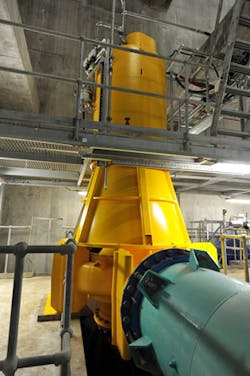The Big Question: Pumps
For the next edition of WWi’s ongoing technology series in which we pose a question to water sector experts, the focus is pumps. We ask: How are technological advances helping to monitor and improve water/wastewater pump energy requirements?
Network optimisation
Thomas Brannemo, SVP & president transport and president, Xylem Europe
Intelligent monitoring and control technologies are revolutionising the water and wastewater pumping industry.
Working in tandem with high performance pumps, monitoring and control technologies can provide water or wastewater operators with total control delivering significant cost-savings by improving pump performance, reducing the number of unplanned call-outs and ensuring optimal energy efficiency throughout the lifetime of the pump.
Our engineers are continuously working to develop ever-smarter solutions to optimise operations. The hydraulic pump design plays a key role in reducing energy consumption as well as lowering life cycle costs. Self-cleaning technology ensures sustained efficiency over time, clog-free operation and reduced total cost of ownership.
Our patented energy minimiser function is an algorithm that provides automatic speed optimisation bringing the energy usage to a minimum. The algorithm continuously monitors the specific energy that a pump is using, and for each new pump cycle the speed is adjusted to ensure the pump is always operating at the optimal speed.
Intelligent technologies can also detect reduced efficiency in aging pumps. Technological advances mean operators can now access real-time performance updates about the entire pumping station, remotely. In the event that the pump is underperforming, the performance is automatically adjusted to ensure optimal energy efficiency under the new circumstances.
Powerful monitoring and control technologies enable pumping stations to communicate with each other, creating an intelligent sewage network. Preventing peak stress in both the network and treatment plant, the network optimisation function lowers energy and maintenance costs.
Incentives to accelerate widespread adoption of proven solutions such as these will result in greater productivity of wastewater operations.
Positive Implications of the ErP Direction
Malcolm Walker, Aturia pump product manager, AxFlow
Originally excluded from the ErP Directive, pumps were added back in 2009 as they were recognised as one of the most important contributors to energy consumption in the EU. The ErP Directive covers pumps for clean water in both residential and commercial settings and is based on the principle that a pump’s performance as a complete product must be efficient, not just the motor.
Although the Directive’s regulations only apply to new pumps, it clearly represents an opportunity to increase sales if customers can be convinced to replace existing pumps with units that comply with the Directive.
Realising this potential is not straight forward for two reasons. Firstly, the Directive’s regulations rest upon a hydraulic efficiency index (MEI) that isn’t as understandable to a customer as is the simple % efficiency as used with the IE regulations for motors. Secondly, in the majority of instances the lion’s share of the efficiencies can be achieved by merely upgrading the motor.
Despite these factors, at AxFlow we have managed to gain some extra sales from the Directive as we are first and foremost a pump supplier. This makes it easier for our trained sales force to explain the mechanics of the hydraulic efficiency index to a customer, and perhaps more importantly the positive implications of pumps that operate near their Best Efficiency Point which is a direct consequence of any pump that meets the ErP regulations.
Built-in intelligence creates new opportunities
Kenth Hvid Nielsen, group vice president, global market segment water utility, Grundfos
Due to changing demands over time, pressure in different parts of water networks is often higher or lower than needed at the moment, and waterworks often safeguards against too low pressure in order to avoid lack of water for any customer.
A typical consequence of this is that pressure increases to a level, higher than necessary in some parts of the system. This causes however, different problems, such as breaks in pipes, water loss, and finally yet importantly waste of energy.
One solution to these problems calls for efficient system surveillance and control. Demand Driven Distribution provides measurement of the network pressure and through this controls pumps at the network’s pumping stations according to these measurements.
A number of battery-driven data loggers transmit the measured values via SMS in the GSM network to a smart adaptive control unit. This unit controls the pumping stations, ensuring that pressure at all times corresponds the needs of water in any part of the network.
Practical experience shows that Demand Driven Distribution provides considerable energy savings. As an example, Essbio-Nuevosur Waterworks Company in the Chilean city of Talca has cut energy consumption by 32% and lowered maintenance costs by preventing breaks in the pipeline and eliminating breakdowns. Against this background, the company considers employing Demand Driven Distribution in 51 plants, covering one million households.
Demand Driven Distribution illustrates how built-in intelligence in the shape of sensors, communication tools, and advanced software algorithms creates new opportunities to monitoring and controlling pumps and systems. In addition to improved energy efficiency, this ensures reliable operation, thanks to preventive maintenance.
By use of cloud-based solutions and data, collected in the products, we will in the future be even better at monitoring and optimising system operation according to changing needs and thus ensure peace in mind for the customers.
Avoiding challenging clogging
Christoph Pauly, press officer, KSB Aktiengesellschaft
Solids in wastewater pose a considerable challenge to operators of sewage systems and pumping stations. They need pumps that are able to cope with a high solids content in the wastewater, operate with minimal wear, require only little maintenance and also consume as little energy as possible.
The energy requirements of a wastewater pump depend decisively on the type of impeller used. Impellers with two or three vanes achieve higher efficiencies than free-flow impellers or single-vane impellers. But impellers with smaller free passages - as is inevitably the case with multi-vane impellers - are more likely to clog.
When choosing a wastewater pump, the right balance between efficiency and functionality must therefore be found in order to select the most economical waste water pump for a given application.
So-called solids separation systems offer an option to combine functional reliability with a pump with high efficiency. In these systems, the solids in the wastewater are filtered out upstream of the pump, the filtered water is collected and progressively ejected.
The solids are thereby removed without entering the pump itself so that the danger of clogging is largely avoided. Wear and tear on the pumps and their maintenance are considerably reduced and pumps with smaller free passages can be used. These provide more energy-efficient and cost-efficient operation.
The somewhat higher investment costs for such pumping stations are offset by lower operating costs in the long term. AmaDS3 from KSB is a wastewater pump station with solids separation system which handles inflow rates of up to 200 m³ per hour at heads of up to 85 m as a standard. Since only mechanically pre-treated wastewater flows through the pump’s hydraulic system, pumps with smaller free passages can be installed, allowing the use of more efficient impellers otherwise unsuitable for this type of application.
This means that raw wastewater can now be pumped across long discharge pipes or large differences in height with economical and durable pumping equipment.
Using hydraulically optimised pumps and high-efficiency motors as well as optimally matching the entire system to the components can cut the energy consumption by as much as 40% when compared with that of old waste water transport facilities.
Keeping it simple
Andy Wilson, business development manager, Bedford Pumps & Hidrostal
Before we answer this question from a wastewater perspective, we must first ask a different question: What are the main causes of excessive energy consumption in wastewater pumping stations?
- Poor pump selection
- Poor station design
- Poor control philosophy
- Lack of maintenance
Don’t just use technology to treat the symptoms, work on the causes and obtain better Totex (total expenditure) outcomes through best practise. Sometimes this may require the initial Capex (capital expenditure) to be higher in order to reap the bigger rewards that long term Opex (operational expenditure) payback offers.
Monitoring and measuring to help reduce energy consumption does not have to be high cost technology. A simple but effective method could be to measure and monitor trends in flow and mains input power. Then arrive at benchmark figures for the basic Specific Energy of each pumping station. This identifies the pumping stations that start to consume more power. Resources can then be deployed to investigate and unblock pumps or replace worn components as part of a site based or back to base, pump overhaul program.
Specific Energy is what you are getting for your money and is simply expressed as kWh/m3. Equipment required is a power meter and clamp on flow meter that record, transmit or store data. Then collate this data in an Excel spreadsheet and deploys resources as appropriate to reduce energy consumption as trends rise station by station. Monitoring and measuring alone will not save energy by itself. It’s what you do with the data and how you manage and deploy resources that delivers savings.
Extended research to save energy
Lauro Antipodi, research & development, Caprari SPA
Directive 2005/32/EC, known as “EuP” and, successively, Directive 2009/125/EC, called “ErP”, triggered off a series of analyses in Europe that led to regulations aimed at establishing ecodesign requirements for industrial products that use electric power.
The European Working Group for the pump industry was called Lot 11 and led to the establishment of Regulation 547/2012/EC, the aim of which was to eliminate pumps with inferior hydraulic efficiency ratings from the European market.
The result of minimum threshold value MEI=0.4, which came into force in January 2015, was that 40% of the pumps that were sold in 2005, that is to say those with lower efficiency ratings, could no longer be placed on the market. However, the analysis has now spread to regulatory systems covering a wider scope, assemblies for example: pump + motor + frequency changer, the so-called “extended product approach”.
With help from Caprari, the Federico II University of Naples has set up the HELab laboratory for assessing conformity to Regulation 547/2012/EC and for studying and testing the “extended product approach” procedures currently being developed at the University of Darmstad under the direction of a Working Group from Europump (European Association of Pump Manufacturers).
When it comes water supply grids, high pressures must sometimes be used to reach distant, inaccessible users. In branches of the grid nearer to the pumping station these pressures are excessive and dangerous for the integrity of the grid itself, so they are lowered by pressure reducing valves.
To avoid this waste of energy, a PaT (Pump as Turbine) can be installed instead of the pressure-reducing dissipating valve. Instead it produces energy by means of a self-regulating system that generates power, thereby reducing the pressure.
In light of this, Caprari and Federico II University are participating in another HORIZON 2020 project called SHINE “Smart Hydropower for Improved Network Efficiency”. Coordinated by Trinity College, Dublin, it is currently being assessed by the European Commission. The aim is to build ten energy recovery systems with PaT in different areas: industry, distribution of drinking water, agricultural irrigation and water treatment systems.
The purpose of these projects is not to discover new products or new processes, but to create methods of use, provide data from real applications and disseminate the successful results obtained for the purpose of promoting and increasing these applications, thereby achieving the maximum possible energy savings and recovery.
More Water & WasteWater International Archives Issue Articles

